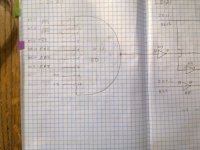daver2
10k Member
I now see what you are trying to accomplish - although I don't necessarily agree with it.
Are you using this logic to also decode for the printer and reader or not? If not, then incorporating disabling of the ION and IOF signals when device 03 or 04 is present is an unnecessary complication.
From my logic analysis, when I feed device 00 into your logic - I get a '1' out - which correctly enables the ION/IOF logic that follows it (assuming you don't have the inverter present as in the original schematic that is).
When I feed device 03 in - the logic appears to correctly disable the ION/IOF logic.
However, when I feed device 04 in - I seem to get the ION/IOF logic enabled - which is incorrect.
Your circuit will also only work with devices 00, 03 and 04. Enhancing your PDP (by say the addition of another UART) would require further modifications to this logic to disable the new device as well as devices 03 and 04.
The '6'XXX is incorporated later on in schematic LD21 by inputs 5 and 13 to to K18.
My strong recommendation is that you revert the logic back to decoding device 00 only as an enable signal.
I will try and work out what logic you require after I come back from my evening walk though.
Dave
Are you using this logic to also decode for the printer and reader or not? If not, then incorporating disabling of the ION and IOF signals when device 03 or 04 is present is an unnecessary complication.
From my logic analysis, when I feed device 00 into your logic - I get a '1' out - which correctly enables the ION/IOF logic that follows it (assuming you don't have the inverter present as in the original schematic that is).
When I feed device 03 in - the logic appears to correctly disable the ION/IOF logic.
However, when I feed device 04 in - I seem to get the ION/IOF logic enabled - which is incorrect.
Your circuit will also only work with devices 00, 03 and 04. Enhancing your PDP (by say the addition of another UART) would require further modifications to this logic to disable the new device as well as devices 03 and 04.
The '6'XXX is incorporated later on in schematic LD21 by inputs 5 and 13 to to K18.
My strong recommendation is that you revert the logic back to decoding device 00 only as an enable signal.
I will try and work out what logic you require after I come back from my evening walk though.
Dave

